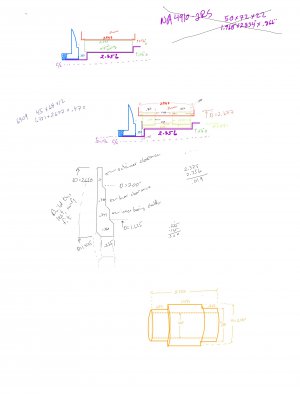@rabler
I think I understand the sketches, except I'm not certain about the part noted "Build this last, . . .".
Is that part to be retained by the pressure plate and needed to axially load the new inner sleeve/bearings against the existing spindle shoulder.
If otherwise, please elucidate.
You have homed in on the key issue in this design. A variation of that part existed in the original. It was essentially a large washer. But it was hardened as if it was a bearing part. The original part fit in there quite sloppily, and rattled like crazy. Something was amiss. The inner and outer race for the needle bearing was hardened, the shaft isn’t, nor is the cast iron pulley.
The shaft has a circular groove in it about .235” to the left of where the shaft steps down from 1.625 to 1.312. I tried to illustrate that in the second drawing. It looks like a groove for a circular retaining ring. It would seem that spring retaing circlips had not come into popular use, much is done with a retaining ring of circular cross section. There was no such retaining ring actually installed, although two where used in the original design to hold the bearing in the sheeve.
When I’d had this apart previously, I’d assumed the pressure plate back was intended to be flush against that hardened washer, but the dimensio don’t work. The pressure plate is held in place by two set screws that have significant pre-drilled divots to lock into. Best I can tell with those set screws installed, there is .390 between the 1.625/1.3125 shoulder and the pressure plate.
My intention is to go with the circular retaining ring hypothesis. I’ll need to make one by annealing, forming, and rehardening some music wire. Since such a ring is not as secure against axial force as a modern retaining clip, the technique seems to favor using a chamfered surface to provide some compression to hold that ring more securely. I have that “washer” marked to build last as I am skeptical of my measurements, so I’ll want to install the sleeve and bearings and measure from there for final dimensions. I don’t need the inner most (thickest) step on that washer, as that would press against the 1.625/1.312 step rather than keeping the bearings and sleeve tight.
I am trying to keep the bearings axially constrained by the right shoulder, sleeve, and retaining washer. Since they are not tapered/anguar bearings I don’t think an axial compression preload through the pulley is ideal. The original design used needle bearings so axial forces don’t seem to be a problem. Might be worthwhile to rebalance the pulley.
Much of this would probably be obvious if I had a fully detailed CAD drawing posted here.

